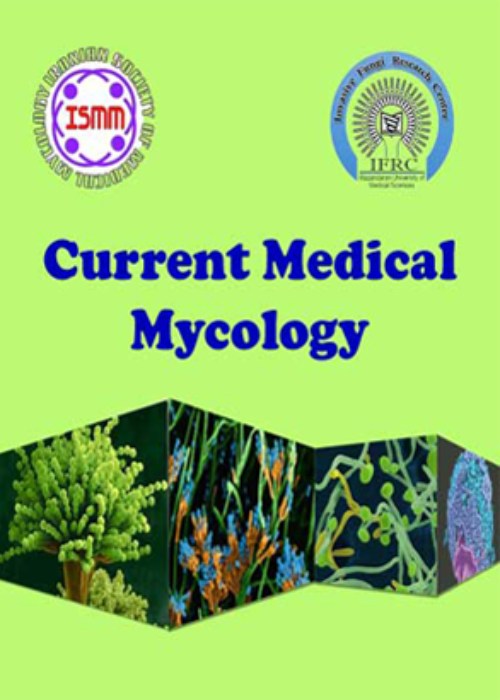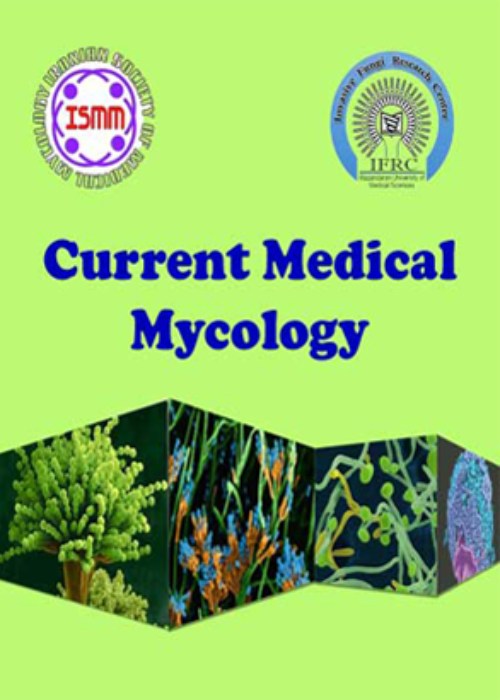فهرست مطالب

Current Medical Mycology
Volume:8 Issue: 4, Dec 2022
- تاریخ انتشار: 1402/03/31
- تعداد عناوین: 7
-
-
Pages 1-8Background and Purpose
The hospital environment was reported as a real habitat fordifferent microorganisms, especially mold fungi. On the other hand, these opportunistic fungi were considered hospital-acquired mold infections in patients with weak immune status. Therefore, this multi-center study aimed to evaluate 23 hospitals in 18 provinces of Iran for fungal contamination sources.
Materials and MethodsIn total, 43 opened Petri plates and 213 surface samples werecollected throughout different wards of 23 hospitals. All collected samples were inoculated into Sabouraud Dextrose Agar containing Chloramphenicol (SC), and theplates were then incubated at 27-30ºC for 7-14 days.
ResultsA total of 210 fungal colonies from equipment (162, 77.1%) and air (48,22.9%) were identified. The most predominant isolated genus was Aspergillus (47.5%),followed by Rhizopus (14.2%), Mucor (11.7%), and Cladosporium (9.2%). Aspergillus(39.5%), Cladosporium (16.6%), as well as Penicillium and Sterile hyphae (10.4% each),were the most isolates from the air samples. Moreover, intensive care units (38.5%) andoperating rooms (21.9%) had the highest number of isolated fungal colonies. Out of 256 collected samples from equipment and air, 163 (63.7%) were positive for fungal growth.The rate of fungal contamination in instrument and air samples was 128/213 (60.1%) and 35/43 (81.2%), respectively. Among the isolated species of Aspergillus, A. flavus complex (38/96, 39.6%), A. niger complex (31/96, 32.3%), and A. fumigatus complex (15/96, 15.6%) were the commonest species.
ConclusionAccording to our findings, in addition to air, equipment and instrument should be considered among the significant sources of fungal contamination in the indoor environment of hospitals.Airborne fungi, Hospital, Indoor air, Equipment, Sources of fungal contamination
Keywords: Airborne fungi, Hospital, Indoor air, Equipment, Sources of fungal contamination -
Pages 9-14Background and Purpose
Genotyping of pathogenic microorganisms is important for epidemiological studies and the adoption of appropriate strategies to control infectious diseases. In this regard, the present study aimed to genotype Candida albicans strains isolated from vulvovaginal candidiasis (VVC) patients using combined ABC type (25SrDNA) and repetitive sequence (RPS) typing systems. using combined typing systems of ABC type (25SrDNA) and repetitive sequence (RPS).
Materials and MethodsIn total, 140 patients with VVC were investigated. Vaginal discharges were collected on Sabouraud dextrose agar and identified by CHROMagar. After species identification, a polymerase chain reaction system targeting 25S rDNA as well as ALT repeats in the RPS was designed to determine C. albicans genotypes. The dendrogram was constructed by zero-one matrix data based on the combination of ABC and RPS typing systems. Statistical analysis of data was performed in SPSS software (version 23).
ResultsIn total, 41 (29.3%) Candida isolates were obtained from 140 VVC patients. The most common Candida species that were identified included C. glabrata (56.1%) and C. albicans (39%). Genotype A3 with five isolates (31.25%) had the highest frequency, followed by B2/3 with three isolates (18.3%), A3/4, C3/4, and B3/4 with two isolates (12.5%), and C2/3 and C3 with one isolate (6.25%), respectively. No significant association was found between the genotypes and antifungal resistance (P<0.05).
ConclusionThe results showed that non-albicans Candida species are more prevalent in VVC patients, compared to C. albicans. The results also indicated that ABC and RPS typings are useful for rapid genotyping and differentiation of C. albicans isolates in regional and small-scale studies.
Keywords: ALT repeat, candida albicans, Genotyping, RPS, 25S rDNA -
Pages 15-21Background and Purpose
Given the high mortality rate of invasive candidiasis inhospitalized pediatric patients, it is crucial to establish a predictive system to achieveearly diagnosis and treatment of patients who are likely to benefit from early antifungal treatment. This study aimed to assess the Candida colonization index, species distribution, and antifungal susceptibility pattern of Candida strains isolated frompediatric patients with high Candida colonization index (CI)
Materials and MethodsThis study was carried out at the Children’s Medical Center inTehran-Iran. In total, 661 samples were collected from 83 patients. The Candida CI wascalculated according to the descriptions of previous studies. The isolates were identified using polymerase chain reaction-based techniques. The Clinical and Laboratory Standard Institute protocol M60 was used to conduct the antifungal susceptibility test.
ResultsA colonization index greater than 0.5 was confirmed in 29 cases (58% ofpositive samples) with two children developing candidemia. Candida albicans (n=53,49.5%) was the most common Candida species in patients with CI > 0.5. Except foracute lymphoblastic leukemia, no risk factors were linked to a high index in colonizedchildren (P > 0.05). Twelve isolates (7.01%) were multi-azole resistant with high MICsagainst both isavuconazole and ravuconazole and seven strains (4.09%) wereechinocandins resistant.
ConclusionIn pediatric intensive care units, patients are at risk of fungal infection,particularly candidemia. In this study, more than half of the children with positive yeastcultures had CI > 0.5, and 6.8% developed candidemia.
Keywords: Antifungals, Candida colonization index, Candidiasis, Pediatric -
Pages 22-26Background and Purpose
Fungal infection by species of pathogenic Candida withantifungal resistance is currently a serious problem. Treatment with new medications isbecoming more challenging to manage this type of infection. The present study aimed to investigate the antifungal effect of essential oils (EOs) against itraconazole-resistantspecies of pathogenic Candida.
Materials and MethodsSeven essential oils were tested on 15 clinical isolates ofitraconazole-resistant Candida from patients with vulvovaginal candidiasis. Theantifungal action of selected EOs was evaluated using the disc diffusion method with the determination of the minimum inhibitory concentration (MIC) of effective EOs.
ResultsRadish EO was the most effective type against all Candida isolates with MICsbetween 3.125% and 6.25% (v/v) .It also had a stronger effect than itraconazole. Sixother EOs showed antifungal effects at varying concentrations and were dependent upon the type of isolate. Low concentrations of these six EOs were more effective against many isolates than their high concentrations. Moreover, camphor and linseed EOs were less effective on isolates.
ConclusionRadish EO has a strong antifungal activity against itraconazole-resistancespecies of Candida, even more than itraconazole. The antifungal action of some EOs can be increased through the use of low concentrations.
Keywords: Candida, Essential oil, itraconazole, Radish, Resistance -
Pages 27-31Background and Purpose
Scedosporium species are ubiquitous environmental fungi,which are considered emerging agents that trigger disease in humans and animals. Thepresent study aimed to determine Scedosporium dehoogii strain isolated from paddy field soil samples using semi-selective media and evaluate its antifungal susceptibility profile.
Materials and MethodsThree paddy field soil samples were collected during aninvestigation for the isolation of Scedosporium species in Mazandaran province, Iran.Morphological and molecular analyses based on ITS-rDNA sequencing were performed. Furthermore, in vitro antifungal susceptibility testing for conventional drugs and novel imidazole (luliconazole) was performed based on Clinical and Laboratory Standards Institute M38-A3 guidelines.
ResultsIn this study, S. dehoogii was isolated from the soil in paddy fields. Based onthe results, itraconazole and luliconazole showed the least and most antifungal activityagainst this isolate, respectively.
ConclusionBased on the findings, molecular identification was essential fordistinguishing the species of S. dehoogii. Remarkably, luliconazole showed potent activity against this strain.
Keywords: Antifungal susceptibility, Molecular identification, Morphology characteristic, Paddy field soil, Scedosporium dehoogii -
Pages 31-35Background and Purpose
Cerebral aspergillosis is a notorious disease that causesrapid clinical deterioration and carries a poor prognosis. Therefore, it requires timelydiagnosis and prompt management.
Case Report:
This study reports a case of fungal cerebral abscess in a 26years old manfollowing hemodialysis,2 months afterdengue-induced acute kidney disease. Aspergillus fumigatus was recovered from a brain abscess specimen that was subjected to a parietal craniotomy. The patient was successfully treated with oral Voriconazole 400mg BD for 2 days, followed by 200 mg BD for 3months
ConclusionHemodialysis patients are at high risk offungal infections due to thefrequent use of catheters or the insertion of needles to access the bloodstream. Therefore, a high index of suspicion of fungal infection is required in patients with hemodialysis by the clinician for early diagnosis and treatment.
Keywords: Aspergillus fumigatus, Cerebral abscess, hemodialysis -
Pages 36-40Background and Purpose
Trichophyton quinckeanum, a known zoophilicdermatophyte responsible for favus form in rodents and camels, is occasionally reported to cause human infections.
Case Report:
This study aimed to report a case of tinea corporis caused by T. quinckeanum that experienced annular erythematous pruritic plaque with abundantpurulent secretions. In June 2021, a 15-year-old girl with an erythematous cup shape lesion on the right wrist bigger than 3 cm in diameter was examined for tinea corporis. Since March, 2016 her family has kept several camels at home. Direct examination of skin scraping and purulent exudates revealed branching septal hyaline hyphae and arthrospore. Morphological evaluation of the recovered isolate from the culture and sequencing of ITS1-5.8S rDNA-ITS2 region resulted in the identification of T. quinckeanum. Antifungal susceptibility testing showed that this isolate had low minimum inhibitory concentration (MIC) values for luliconazole,terbinafine, and tolnaftate, but high MICs to itraconazole, fluconazole, posaconazole, miconazole, isavuconazole, ketoconazole, clotrimazole, andgriseofulvin. However, the patient was successfully treated with oral terbinafine andtopical ketoconazole.
ConclusionIt can be said that T. quinckeanum is often missed or misidentified due to its morphological similarity to T. mentagrophytes/T. interdigitale or other similar species. This dermatophyte species is first reported as the cause of tinea corporis in Iran. As expected, a few months after our study, T. quinckeanum was detected in other areas of Iran, in a few cases
Keywords: antifungal susceptibility profile, T. quinckeanum, Tinea corporis


